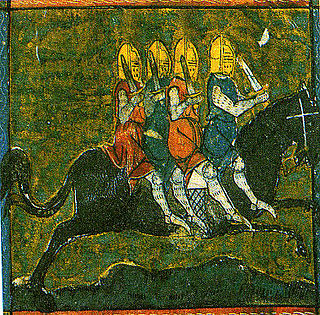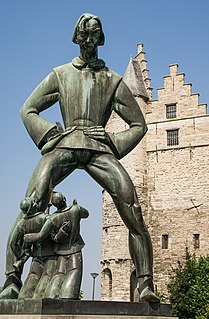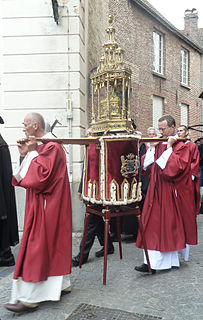 W
WBayard is a magic bay horse in the legends derived from the chansons de geste. He is renowned for his spirit, and possesses the supernatural ability to adjust his size to his riders.
 W
WThe Carnival of Aalst or Aalst Carnival is an annual three-day event in the Belgian city of Aalst that was removed as a UNESCO Masterpiece of the Oral and Intangible Heritage of Humanity amid controversy over the use of anti-Semitic stereotypes in 2019 during the carnival and in its promotional materials, in addition to previous controversies. The carnival is celebrated in the days preceding Ash Wednesday. It is mainly a street happening; the celebrants dance on the city squares and visit café after café.
 W
WThe carnival of Binche is an event that takes place each year in the Belgian town of Binche during the Sunday, Monday, and Tuesday preceding Ash Wednesday. The carnival is the best known of several that take place in Wallonia, Belgium at the same time and has been proclaimed as a Masterpiece of the Oral and Intangible Heritage of Humanity listed by UNESCO. Its history dates back to approximately the 14th century.
 W
WDruon Antigoon or Druon Antigonus is a Flemish folkloric character. He was a mythical giant who lived in Antwerp.
 W
WThe Ducasse d'Ath is a traditional parade held to mark the victory of David over Goliath. It takes place in the town of Ath in Belgium. It has been recognized as one of the Masterpieces of the Oral and Intangible Heritage of Humanity by UNESCO, under "Processional giants and dragons in Belgium and France". The parade is held on the 4th Sunday of August every year and is characterized by the presence of large giants depicting many characters from local history.
 W
WThe Ducasse de Mons or Doudou is a popular festival that happens every year on Trinity Sunday in the town of Mons in Belgium. It is recognised as one of the Masterpieces of the Oral and Intangible Heritage of Humanity since November 2005, under "Processional giants and dragons in Belgium and France".
 W
WDulle Griet, also known as Mad Meg, is a figure of Flemish folklore who is the subject of a 1563 oil-on-panel by Flemish renaissance artist Pieter Bruegel the Elder. The painting depicts a virago, Dulle Griet, who leads an army of women to pillage Hell, and is currently held and exhibited at the Museum Mayer van den Bergh in Antwerp.
 W
WFolklore of the Low Countries, often just referred to as Dutch folklore, includes the epics, legends, fairy tales and oral traditions of the people of Belgium, Netherlands and Luxembourg. Traditionally this folklore is written or spoken in Dutch or in one of the regional languages of these countries.
 W
WThe Four Sons of Aymon, sometimes also referred to as Renaud de Montauban is a medieval tale spun around the four sons of Duke Aymon: the knight Renaud de Montauban, his brothers Guichard, Allard and Richardet, their magical horse Bayard, their adventures and revolt against the emperor Charlemagne. The story had a European success and echoes of the story are still found today in certain folklore traditions.
 W
WGenevieve of Brabant is a heroine of medieval legend. The story is told in the "Golden Legend and concerns a virtuous wife falsely accused of infidelity.
 W
WThe Gilles are the oldest and principal participants in the Carnival of Binche in Belgium. They go out on Shrove Tuesday from 4 am until late hours and dance to traditional songs. Other cities, such as La Louvière, have a tradition of Gilles at carnival, but the Carnival of Binche is by far the most famous. In 2003, the Carnival of Binche was proclaimed one of the Masterpieces of the Oral and Intangible Heritage of Humanity by UNESCO.
 W
WHeer Halewijn is a Dutch folk tale which survives in folk ballad. Although the first printed version of the song only appears in an anthology published in 1848, the ballad itself is first written down in the 13th century but dates back to pre-Christian times and is one of the oldest Dutch folk songs with ancient subject matter to be recorded. The story of lord Halewijn itself is even older and contains elements going back to Carolingian times. Many of its mythemes range back to Germanic pre-Christian legends.
 W
WThe Kattenstoet is a parade in Ypres, Belgium, devoted to the cat. It has been held regularly on the second Sunday of May since 1955. Most recently, the 45th edition took place on May 13, 2018. The parade commemorates an Ypres tradition from the Middle Ages in which cats were thrown from the belfry tower of the Cloth Hall to the town square below.
 W
WKrakelingen and Tonnekensbrand are the names of annual centuries-old festivities in Geraardsbergen. The summit of the event is the Krakelingenworp at the top of the Oudenberg hill. At the same day and place the Tonnekensbrand has place in the evening. The double festivity was inscribed in the Inventory of Immaterial Cultural Heritage of Flanders in 2009, and UNESCO's lists of Intangible Cultural Heritage in 2010.
 W
WLange Wapper is a Flemish folkloric character. He is a legendary giant and trickster whose folk tales were told especially in the city of Antwerp and its neighbouring towns, but similar tales are also prominent in other Flemish cities.
 W
WThe Legend of Thyl Ulenspiegel and Lamme Goedzak is an 1867 novel by Belgian author Charles De Coster. Based on the 14th-century Low German figure Till Eulenspiegel, Coster's novel recounts the allegorical adventures as those of a Flemish prankster, Thyl Ulenspiegel, directly before and during the Dutch Revolt against Spanish rule in the Netherlands.
 W
WThe Little Mouse, or La Petite Souris, is a fairy tale legend popular in most Francophone countries, most notably in France, and Wallonia. The legend of the Little Mouse ties in with that of the Tooth Fairy, the difference being that in this case, a little mouse sneaks in while the child is asleep, and replaces the lost baby tooth kept under their pillow with coins.
 W
WManneken Pis is a landmark 61 cm (24 in) bronze fountain sculpture of a puer mingens in central Brussels (Belgium), depicting a naked little boy urinating into the fountain's basin. It was designed by Jérôme Duquesnoy the Elder (1570–1641), and put in place in 1618 or 1619. The current statue is a replica which dates from 1965. The original is kept in the Brussels City Museum. Manneken Pis is the best-known symbol of the people of Brussels. It also embodies their sense of humour and their independence of mind.
 W
WThe Marches of Entre-Sambre-et-Meuse are a set of folk marches, taking place from May to October, in Belgium in Entre-Sambre-et-Meuse. Ancient religious processions dedicated to local saints, protectors of parishes have taken over time a folkloric character, without the religious aspect getting totally lost. They are accompanied by armed escorts, which are just as well traditional.
 W
WOmmegang or Ommeganck is the generic name for various medieval pageants celebrated in the Low Countries.
 W
WPère Fouettard is a character who accompanies Saint Nicholas on his rounds during Saint Nicholas Day dispensing lumps of coal and/or beatings to naughty children while St. Nicholas gives gifts to the well behaved. He is known mainly in the far north and eastern regions of France, in the south of Belgium, and in French-speaking Switzerland, although similar characters exist all over Europe. This "Whipping Father" was said to bring a whip with him to spank all of the naughty children who misbehaved.
 W
WThe Procession of the Holy Blood is a large religious Catholic procession, dating back to the Middle Ages, which takes place each Ascension Day in Bruges, Belgium. In 2009, it was included in the UNESCO Representative List of the Intangible Cultural Heritage of Humanity.
 W
WThe processional giants and dragons of Belgium and France are a set of folkloric manifestations which have been inscribed by UNESCO on the lists of Intangible Cultural Heritage in 2008, originally proclaimed in November 2005.
 W
WReynard the Fox is a literary cycle of medieval allegorical Dutch, English, French and German fables. The first extant versions of the cycle date from the second half of the 12th century. The genre is very popular throughout the Late Middle Ages, and in chapbook form throughout the Early Modern period.
 W
WRos Beiaard of Dendermonde is a large folkloristic horse. It differs from the other Ros-Beiaard horses because it is used only once every ten years and because the horse is carried by people. The Ros Beiaard is on UNESCO's list of Masterpieces of the Oral and Intangible Heritage of Humanity, under the "Processional giants and dragons in Belgium and France".
 W
WSilvius Brabo [ˈsɪɫviəz ˈbraːboː] was a mythical Roman soldier who was said to have killed a giant, and by this would have created the name Brabant.
 W
WSinterklaas or Sint-Nicolaas is a legendary figure based on Saint Nicholas, patron saint of children. Other Dutch names for the figure include De Sint, De Goede Sint, and De Goedheiligman. Many descendants and cognates of "Sinterklaas" or "Saint Nicholas" in other languages are also used in the Low Countries, nearby regions and former Dutch colonies.
 W
WSaint V is the commonly used name for a holiday for freethinking university students in Brussels, Belgium, celebrating the founding of the Free University of Brussels. The day's long form differs in the two official languages, but both are a reference to Pierre-Théodore Verhaegen, the founder of the university, who notably is not a saint and was never canonized; the name was chosen to mock the Saint-Nicolas festivities of the rival Catholic University instead. The festivities take place on November 20, commemorating the anniversary of the university's official opening. It is celebrated by students of both the Université Libre de Bruxelles and the Vrije Universiteit Brussel, which officially separated in 1970.
 W
WTill Eulenspiegel is the protagonist of a German chapbook published in 1515 with a possible background in earlier Middle Low German folklore.
 W
WZwarte Piet is the companion of Saint Nicholas in the folklore of the Low Countries. The earliest known illustration of the character comes from an 1850 book by Amsterdam schoolteacher Jan Schenkman in which he was depicted as a black Moor from Spain. According to folklore, the skin of Zwarte Piet is colored by soot from going down chimneys to bringing presents into people's houses. Those portraying Zwarte Piet usually put on blackface and colourful Renaissance attire in addition to curly wigs and bright red lipstick. In recent years, the character has become the subject of controversy.